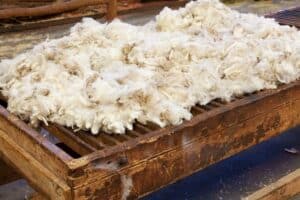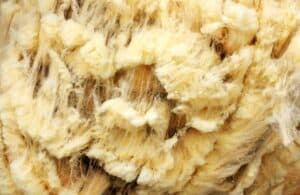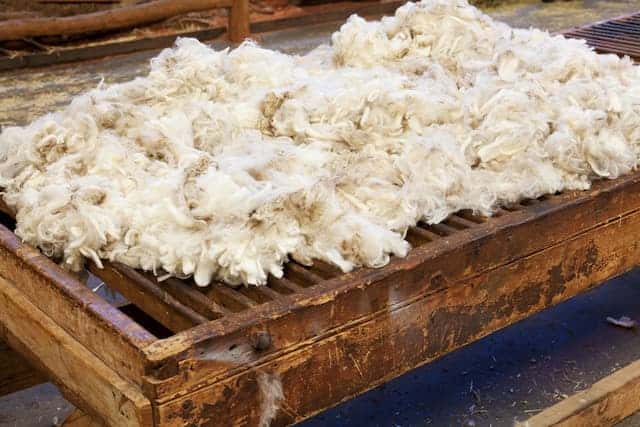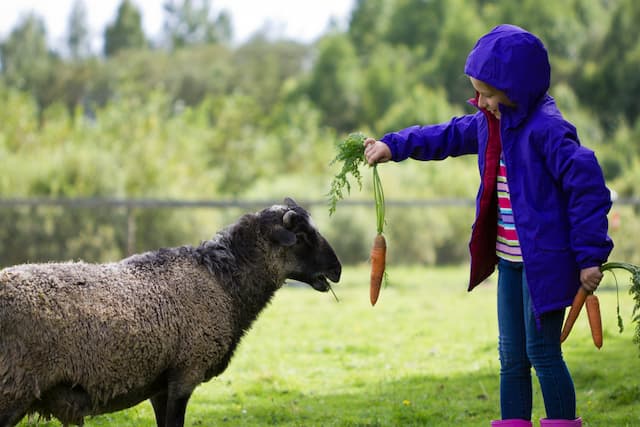Wondering what to do with raw wool? Well, the most obvious use of sheep wool is in making clothing. However, this use isn’t practical for farmers, as thread usually needs processing before it turns into useful fabric.
Raw wool is the untreated fleece shorn from sheep. Despite shearing large flocks yearly, many farmers don’t know what to do with raw wool and often discard it.

How to Use Raw Wool
The first step to using raw wool involves removing dung locks and grease tags. This is known as the cull clip.
When cleaning the fleece, please avoid scouring. Scouring removes lanolin, a waxy substance that sheep secrete to keep the fleece waterproof and protect the animal’s skin. Removing the lanolin makes the wool dry and difficult to spin.
What Do You Do With Raw Wool After Shearing?
If you do not know what to do with raw wool, here are some practical uses of raw wool.
Insulation
Wool is an excellent insulator. However, it isn’t as popular as other insulation options, especially fiberglass. This is because processed wool is costlier than fiberglass, and its supply is often low.
Many farmers are unaware that wool doesn’t need processing to become an effective insulation solution.
After removing the lanolin and grease tags, you can use the wool as insulation. And since raw wool is easy to access, you won’t have supply problems.
Mulching
You can use raw wool as mulch in your garden. Sheep wool clippings, fleeces, and wool mates can help your plants to conserve water, especially during the dry season. Mulching is particularly useful if your plants grow under irrigation, ensuring you don’t use too much water.
In winter, mulching promotes plant health by protecting the roots from frost. In addition, the insulation property of wool ensures the root cells don’t freeze due to cold temperatures.
Usually, frost damage occurs when root cells freeze and later expand, causing them to rupture, which kills the plant.
Fertilizers
Most farmers believe that droppings are the only product from sheep they can use as fertilizer. But, in reality, raw wool is also an excellent nutrient source for growing plants.
It’s worth noting that you can’t use raw wool as it is after shearing your sheep. Rather, you’ll need to extract the dags.
Dags are the poo balls that attach to the fleece as it grows. However, some sheep don’t have dags, those that do maintain them until shorn.
After shearing, pull off the dags from the wool. Then, collect them into a heap and later spread them in your garden.
The best time to do this is a few weeks before it starts raining. Rain is essential in breaking down the dags to become useful to plants.
Holding Water for Plants
Because of its excellent moisture retention ability, more people are using raw wool to hold water for plants. The technique involves placing wool in hanging baskets, adding water, and letting it drip slowly to a nearby plant.
It works like drip irrigation, with the wool serving as a water reservoir that releases water in small amounts to minimize wastage and reduce the risk of overwatering.
READ ALSO: Will Sheep Drink from Running Water? (Is It Safe?)
Hügelkultur
Hügelkultur is a new gardening approach involving raised gardens built from the ground upwards.
First, the farmer adds various waste materials, including branches, leaves, logs, food remains, grass clippings, manure, and anything you would find in a typical compost heap. Afterward, he adds soil to cover the waste.
Covering the compost heap triggers decomposition. When the waste decomposes, it releases nutrients that promote healthy plant growth.
If you have unused raw wool, consider throwing it into your hügelkultur compost mix. Its excellent water retention keeps the pile moist and accelerates decomposition. Furthermore, wool is biodegradable and won’t affect the garden’s nutritional value.
Building Paths
Another creative way of using wool is to make pathways. Sometimes, wool might be too felted to spin or so dirty that you can’t use it in handcrafting. In such cases, one practical way is to use it as a plastic alternative for making walkways.
To use it, scape soil from the area you intend to create the pathway. Then, lay down a three-inch layer of uncompressed wool and cover it with stone.
It will feel ‘springy’ for the first few days. However, that feeling subsides after substantial use to give way to a firm and solid surface.
The most impressive thing about wool on pathways is that it prevents weed growth. This makes maintenance easy, as you don’t have to waste time dealing with grass and other undergrowth that interfere with your walkway’s appearance.
Animal Beddings
One of the significant causes of sickness in animals is poor hygiene, especially when they sleep.
For instance, your sheep are at a high risk of bacterial infections when they sleep on their droppings or on a wet floor. This is a problem you can solve by lining wool on the floor.
Raw wool is a great absorbent material when you lay it on the barn floor. It absorbs moisture, keeping your animals dry.
It’s breathable, allowing it to release moisture when the surroundings are dry and absorbent when the air is damp.
Besides, wool has insulation properties that keep animals warm, lowering the risk of respiratory diseases.

How to Store Raw Wool
Every sheep farmer has their preferred method of storing shorn wool. Some wash it to remove dirt before storing, while others keep it as it is. Regardless, unwashed and untreated raw fleece requires extra care to maintain usability after storage.
If you live in a cool and dry region, it’s easier to store your wool than in hot, humid areas. High temperatures provide optimum conditions for bacteria and other organisms that promote decomposition.
Here are useful tips for taking care of raw wool.
Skirt the Fleece
The first step involves removing the dirty manure tags on the sheep’s fleece. This prevents urine and fecal matter from contaminating the wool during storage.
More importantly, this removes the unpleasant odor, which often worsens if you store the fleece unwashed.
When skirting the fleece, prioritize the sweat locks. These are the greasy, black locks near the armpit area of your animal’s four limbs.
Sweat locks are easy to spot on light-colored sheep. However, they might not be apparent in dark-hued animals.
Always take time and ensure you skirt the fleece correctly before storage. It makes it easier to handle the wool in the future.
Protect the Fleece from Adverse Conditions
As hinted, raw wool becomes more susceptible to damage when exposed to extreme conditions, such as low temperatures and hot, humid environments.
Keep it in a muslin bag or sheeting to prevent raw wool deterioration. These have adequate ventilation, allowing air to move in and out seamlessly and preventing decomposition.
Storing wool in a plastic bag increases the risk of deterioration, especially if you live in a humid area.
When you store wool in plastic, the fibers compact and can even get matted or felt over extended periods. Remember, wool is an excellent absorbent that absorbs moisture, including atmospheric water. To avoid this, it’s advisable to store raw fleece in breathable fabric.
If you have a small herd, old pillowcases can do you good. Their breathability ensures the wool doesn’t get too moist to lose its quality. Large bedsheets from a nearby thrift store can work for large-scale farmers.
After securing the wool in a breathable bag, tie the top with a string. You can then put the wool in a plastic tub.
If you live in a mildly humid climate, throw a desiccant into the plastic tub to help deal with excess moisture.
The best solution for people in hot and wet environments is to put the wool in a cardboard box or a perforated plastic container.
After storage, ensure you label the wool appropriately. Include information about the shearing date, wool color, weight, and type.

Prevent Pest Infestation
Despite the known disadvantages of storing raw wool in plastic, some farmers do it to avoid pest attacks.
Moths and carpet beetles are particularly notorious for attacking exposed fleeces. These pests prefer untreated raw wool to processed wool. Mice are also attracted to unprocessed fleeces.
It isn’t easy to curb moth infestations on raw wool. While moth repellents are effective when applied on treated wool, they don’t work well on unwashed fleeces.
The latter has a pronounced lanolin smell that overcomes the repellent, hampering its effectiveness.
Nonetheless, applying this repellent can help lower the risk of moth attacks. For mice, you can set traps to prevent access to your raw wool.
Conduct Routine Inspections
Even if you adhere to the storage advice mentioned above, extending the storage period increases your wool’s susceptibility to deterioration. In addition, if it’s unwashed or untreated, the lifespan shortens.
The ideal way to prolong its life is to conduct routine inspections to look for pest infestation or matting signs. This way, you’ll know whether to discard or continue keeping the wool.
Wrapping Up
Although wool is always in high demand, some farmers can’t access the market on time. Fortunately, that raw fleece doesn’t have to go to waste. Now that you know what to do with raw wool you can try some of the above ways or even store your natural wool so that you get value for it!
RECENT POSTS
How Many Babies Do Sheep Have? (Per Year and Lifetime!)
Do Sheep Attack Humans? (Things To Know!)
How Fast Can A Sheep Run? (How Fast Exactly?)
Can Sheep Live without a Shepherd? (Reasons They Need a Shepherd!)




